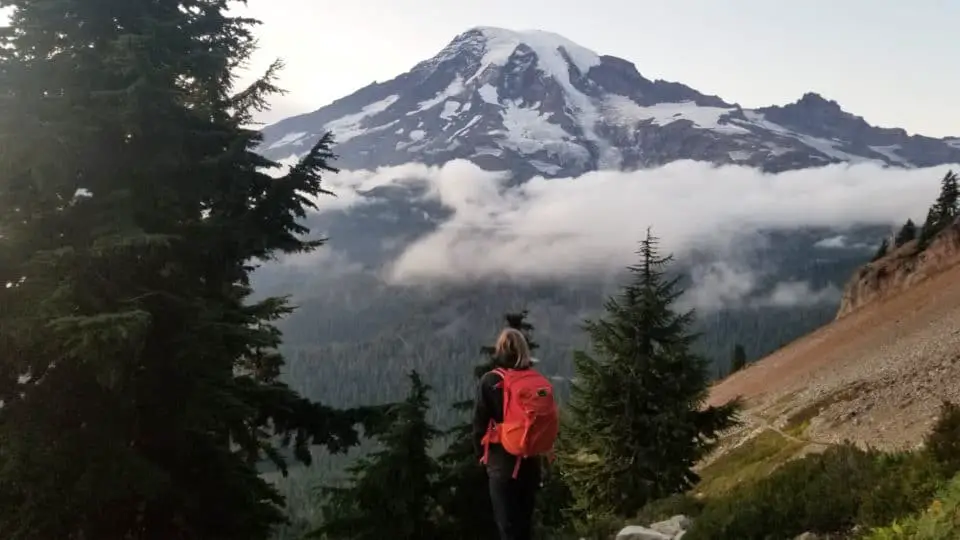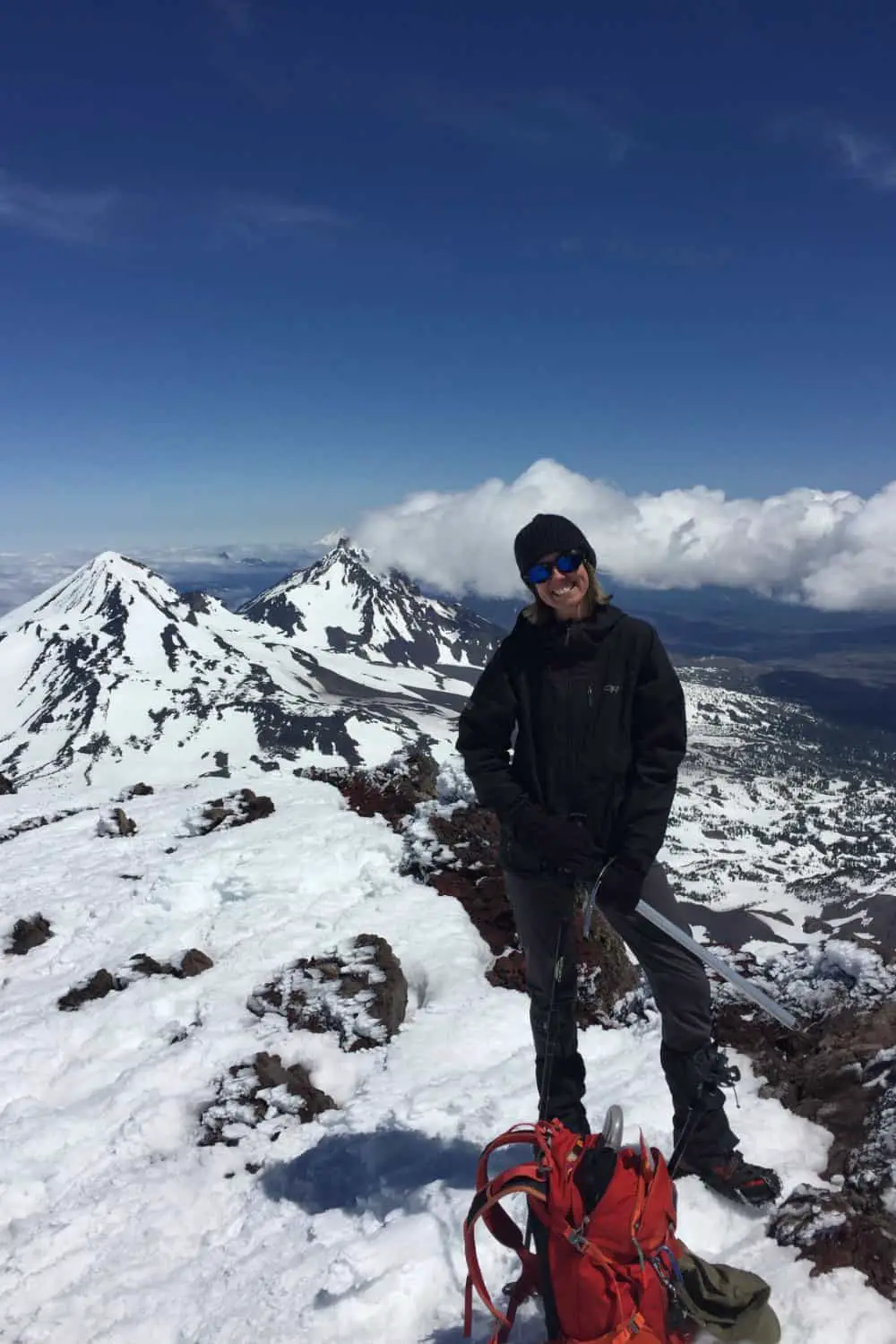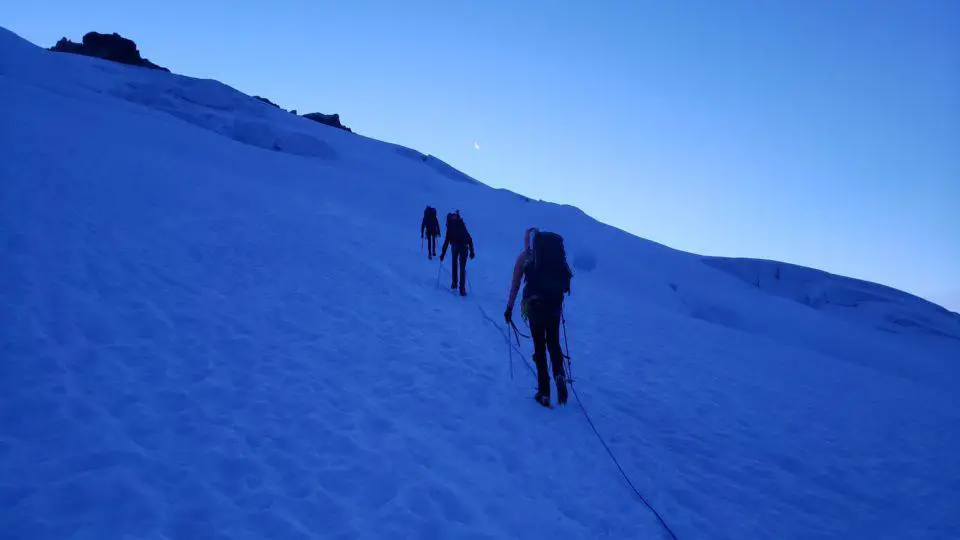“Because it’s there.”
George Mallory’s response to being asked why he wanted to climb Mt. Everest has been quoted so often it’s become a cliché, and at first pass might seem to just be a clever tidbit of wry British humor. But really: when you stop and ask yourself why you do this, why you march through thick brush and deep mud at dusk, why you climb straight up into the heat of day, sweating, squinting, swatting at mosquitoes, why three hours before sunrise are you pulling your parka hood over your face in an attempt to hide from the pellets of ice that have been assaulting you for a mile and a half—when you ask yourself why you do these things, you’ll eventually arrive at the same conclusion: because it’s there.
Of course we all have our own reasons to hike: exercise, alone time, as a social activity, to satisfy the travel sweet tooth, yearly mileage goals, anger management, to take great photos. The expression “do it for the ‘gram” was likely born on a mountaintop. You can meet that special someone hiking, go on hike dates, take your engagement photos at [insert iconic mountainy backdrop of your choosing], get married with your beat-up hiking boots under your fluffy white dress and go on a Patagonian honeymoon. You can then stay together forever and be one of those cute little old trail couples with their sunhats and fragile gait, or you can grow apart and process the breakup over a thousand solo miles of steps and tears. Because the mountains will always provide. The mountains will always give us the answers, whether we ourselves even know the questions yet. And if you just want taut abs and rock-hard quads, the mountains will give you those too.

Some folks stumble into hiking via the side doors of geocaching, hunting, ski touring, or dogwalking. Some rock climbers find that the routes they like have long approaches, and some runners (or their knees) grow tired of city streets, so they too find themselves a part of the trail community. Some enjoy getting groups together to go adventuring, filling the hills with the sounds of laughter and inside jokes, while others go to be alone in silence with their thoughts. For women with kids, it’s something they can do with the kids—or as an escape from the kids. For women struggling with mental health, the mountains can be an outlet for anxiety or a place to transform depression into inspiration. For women who have had their self-esteem whittled down to nothing, it’s hard to imagine a more effective way to build confidence—I’ve seen many go from not believing in themselves at all to climbing 14,000 foot peaks and saying things like “if I can do that, I can do anything.”
A greater form of physical exercise may not exist. Equal parts cardio and strength training, endurance sports demand maximum output from our bodies. And hiking is easily accessible. It doesn’t require membership or lessons, even the least-athletic non-athlete can participate, and it’s free (minus the thousands of dollars you’ll eventually drop on gear, but more on that later). Walking comes naturally; it should, you’ve been doing it since you were a yearling. It’s familiar, the cadence of your own right left right. Until you get to ropes and helmets and axes, it’s not rocket science. And the cool thing is, your first hike might only be a hundred feet of gain over a mile, but if you want to go higher and farther, and you keep at it, and keep pushing, and keep reaching deep, and keep putting in the time, there’s no reason you can’t work up to ten, twenty, thirty mile days. Climbing to the highest point in each state, or trekking the entire PCT, or checking everything off the Bulger List, those things aren’t impossible. That holds a lot of appeal for anyone wanting to stay above their anaerobic threshold for a sustained amount of time, and there’s a lot of potential to become strong in a relatively short amount of time. The Ultralight movement and the increase in popularity of Ultramarathons has created a generation of light-and-fast folks who move through the mountains with a superhuman swiftness, setting speed records previously only dreamed of. Why go to the gym when you can run ridges at dawn, watching the granite slabs around you turn pink under a rainbow sherbet sky as you scramble the last few yards of the summit block. Why jog around the local track when you can get five thousand feet above sea level in just a couple-few hours, your legs loving the burn, every part of you getting stronger and faster with each step.
Are you an introvert or extrovert? Some hike as part of a club, or a group of friends, or with family. It’s not hard to find hiking groups for nearly every town that has trails, and for a lot of people, there’s safety in numbers. Many beginning hikers prefer not to go out alone, and I cannot emphasize this enough: go with your gut and do what feels right for you. If you arrive at a trailhead you’ve never been to before and the parking lot is empty, the latest trip report talks about routefinding, you don’t have a GPS, and you feel uneasy, there is no shame in going back home. Also, many experienced climber-hikers need partners for the kind of roped travel they do, some families use hiking as a bonding activity, and super social folks thrive on coordinating like a travel agent for even the simplest day hikes. But not everyone goes to the mountains to relive their sophomore spring mixer; some seek the desolate solitude of obscure locations and trails that are way off the beaten path—these are the hikers for whom signs like “unmaintained trail” and “unnamed peak” bring joy, the ones who go out there to clear their heads and untangle the knots of their current woes. Solo hikers are their own breed of cat, stubborn and self-sufficient, creative and independent, and usually possess a few super odd quirks from spending so much time alone. While there are some special considerations around emergency preparedness when hiking solo, it’s really much safer than the naysayers would say. Bottom line, you can do either or both, solo or not, but what’s important is that you do what’s right and safe for you and whatever fills your soul at the time, whether that’s a backpacking weekend with the girls or a solo hike to a distant lake with no sound other than the wind in the pines and your feet drumming away at the dirt.
Sometimes the motivation is purely visual. The pictures you will take of or from the spires of jagged remote mountain ranges at dawn will have people thinking you have a fancy camera, when it’s really just your old phone, no filters. You could close your eyes and swing an iPhone 4 around on a rope in the middle of any mountain range and wind up with stunning images. There are days I go out there purely for the colors, the sky drama, for no reason other than eerie lighting or fall foliage.
And sometimes the motivation is a different kind of sensory input that I can never quite put my finger on other than to say “the way the air feels.” Fall, for example, is when I hike purely for the feel of the air and the colors of the hills, when I hike out of sheer enjoyment, with no reason other than to breathe in the whole feeling of that season: my summer goals are out of the way, I’m not obsessively training for anything, it’s not blazing hot but the sun still feels strong and pure in the afternoons, and it’s the last of the “summer” travel before the first snowfall comes to winterize everything. These are the days we don’t keep track of speed, the sauntering days.
The goal-oriented hiker sees mountains as a checklist, a series of challenges that must be completed, and is constantly coming up with new objectives (all Cascade volcanoes, all state high points, the Seven Summits, all of Colorado’s 14ers, the top 50 hikes in your area) and sets out to achieve and accomplish and collect peaks and mileage and icons. If you’ve always been a task-driven person, this is how you roll and I know you have either a notebook or some spreadsheets. I for one have a hallway full of maps plastered with red dots, and love nothing more than getting a new regional hiking guide and checking off every trail in the book. The achievement-junkie in me thrives on seeing how many places I can get to or how fast I can go, or for how long, how far, how many, and keeping track satisfies my OCD and justifies all that time I spend out there, turns it from aimless self-indulgent wandering to a legit project.
But back to why do we do it. If you find yourself spending a lot of time out there, you might find people asking you why, and you might find the answers are too large for the question. There are personal reasons, philosophical reasons, paradoxical reasons (we go to a place we feel small and wind up feeling powerful, we go outside to go within) and those reasons change over the years just like we do, and they change day to day or with the season or with whatever we’re going through. We hike to process grief and to walk off anger, we hike to prove to someone else or to ourselves that we are capable, we hike to feel like we aren’t wasting time, we hike when we are happy and want to go frolic, we hike to see things that many people don’t even know exist. For some of us, we see a peak and feel a magnet inside us lock onto its summit, a strong and instinctual pull upwards. I need to stop here to emphasize the “must” in the phrase “the mountains are calling and I must go” because it really does feel involuntary. This past summer while coming down off the summit block of a particularly gnarly climb (I’m lookin’ at you, Mt. Stuart) my partners and I took turns swearing off hiking completely…all the while planning our next objectives. Because it feels that primal, like it’s not a hobby we picked; it’s a calling, like being a man of the cloth. To paraphrase the thug life saying, I didn’t choose mountains, they chose me.
And that’s why we hike. Because we can’t imagine not. Because we can. Because why wouldn’t you? How can you not want to see everything and get all up in it? Because you only get one life and why spend it on the couch? Because my legs and feet and lungs were designed to be put to use. Because humans are naturally curious. Because some of us have a visceral drive, when we look at something tall, to be on top of it. Because life is too short and I don’t want to punch out feeling like I didn’t get my money’s worth. Because we regret the things we don’t try to do way more than the things we try and fail. Because the things you learn about yourself out there would take years of therapy, and the way you learn about the earth out there by experiencing it with all of your senses at once can’t be taught in school. Because we were given this world as our playground, and we have free reign to stand on top of any mountain we want.
So yes, George—because it’s there.

Wendy Harrington is a California native who has lived in a small town at the foothills of the Cascade Mountains in Washington state since 2001. Her love of trail running and peakbagging has led her to summit all five Washington volcanoes, climb to the high points of three states, and put nearly a thousand miles a year on her boots. Her loves include ridgelines, saddles, granite, one-day pushes on big mountains, anything volcanic, long solo days, and objectives that push limits and test endurance.

